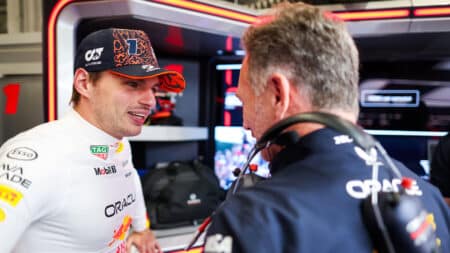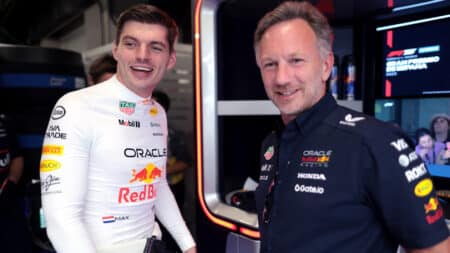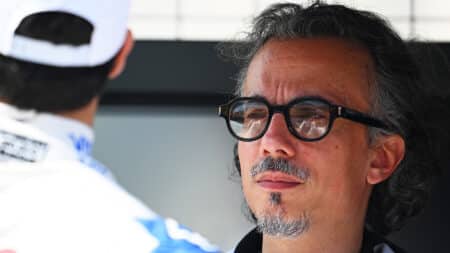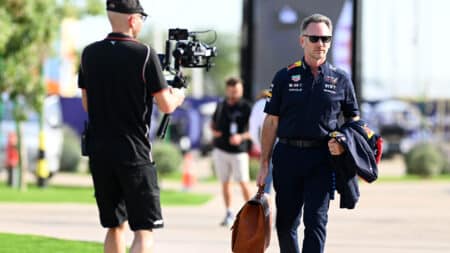
Max Verstappen reacts to Christian Horner's Red Bull F1 exit
Max Verstappen has now had his say after Red Bull confirmed his former F1 boss had left the team
McLaren’s factory has its ornamental lake, a couple of swans and endless identikit corridors borrowed from one of Pinewood’s James Bond sets, but such are not presently the design details that cultivate Formula 1 world championships. Red Bull’s base is more prosaic, an industrial unit nestling on a typical Milton Keynes estate, close to Kingston Foods, Ideal Bathrooms and other, similar institutions. It’s an appropriate setting for a motor sport celebrity who prefers the simple things in life.
There’s no fanfare when Sebastian Vettel turns up for a press conference to celebrate his fourth world title: he’s slightly late, because fog delayed his touchdown at Cranfield, but slips in almost unnoticed wearing Red Bull jacket and jeans.
Outwardly, fresh logos apart, the factory has changed relatively little since it first served as Paul Stewart Racing’s base, before morphing into the home of Stewart Grand Prix, then Jaguar Racing and finally Red Bull Racing. “Something has obviously been going on, though,” Vettel says, “because it’s becoming ever more difficult to find a parking space…”
Chief technical officer Adrian Newey speaks warmly about his team’s unsung surroundings. “It’s the people that make it special,” he says. “What’s good about the factory is that it’s nothing other than it needs to be – it excels in the business of designing, researching and manufacturing racing cars. It’s a great place to work.”
Making his mark early on
Vettel is now part of the furniture, but turned up unannounced when he visited for the first time during the summer of 2005. “He was part of our junior driver programme at the time,” says team principal Christian Horner, “and had just obtained his road licence. One of the very first things he did was to jump in his car, drive from his home in Germany to Milton Keynes and turn up at the door to see whether he could have a look around. We had quite a few youngsters on our scheme at the time, 16 or 18 of them, but he was the only one with the initiative to come to the F1 factory and introduce himself. I was impressed by that.”
Some people tend not to look beyond the caricature Vettel, the winning and grinning finger-wagger of popular culture. He is fuelled by a competitive arrogance, yes, but that’s an essential part of any top-level sportsman’s DNA. The images might be exultant, but the individual behind them is for the most part charming and funny.
I’ve seen his less cheerful side, though: at Brazil in 2009, he stomped almost in tears from the Red Bull garage after his title dreams had finally been extinguished in the slipstream of a storming drive from Jenson Button. “I wasn’t angry,” he said at the time, “just extremely disappointed. You work hard, you believe in something and it can be difficult to deal with the consequences when it doesn’t happen. It’s only natural to show your emotions.
“Do I enjoy my job? Yes. Do I enjoy it a lot? Yes. Do I have a reason to smile? Yes. But am I here only to have fun? No. I have targets and I’m ready to sacrifice a lot to achieve them. Generally I think I’m a happy person, but I’m not trying to be something I’m not – I’m no actor and have always believed an honest approach is best.”
From where did his competitive drive come?
“I’m not sure,” he added. “I tried most sports when I was younger – and hated sharing. I didn’t really enjoy football, for instance, partly because I wasn’t very good – perhaps that’s why the others never gave me the ball. Mainly, though, I think I’m selfish, as you have to be in F1: I want to do things on my own terms.
“I always want to be first, and to be better than the rest, no matter what I do, even silly stuff. I always want to be one step ahead. Driving an F1 car is nice, it’s a lot of fun and not many people enjoy such a privilege, but the driving on its own isn’t enough…”
Staying with Red Bull
After winning two titles with Benetton in the 1990s, Michael Schumacher upped sticks and chased the Ferrari dream (leaving behind a car, the Benetton B196, that the team felt significantly better than either that had carried him to the title, although neither Jean Alesi nor Gerhard Berger coaxed it to victory that season). Vettel, though, is contracted until the end of 2015 and does not anticipate upping sticks any time soon. “I’m very happy where I am,” he says. “It’s about whether you are happy with who you are and if you can look at yourself in the mirror. I’m not thinking about anywhere else, or racing for anyone else.”
Unlike many rivals, who have a management entourage, Vettel negotiates his own contracts and wanders the F1 paddock without an army of bag-carriers.
I have a friend who was very involved in organising an annual motor sport gala and he found Vettel an easy invitee. Other F1 drivers were willing guests, but needed three cars to ferry family and friends, plus this and that: Vettel just required a time and a place and would make his own arrangements. He’d also stay at the end to make sure he’d thanked his hosts.
Ahead of the 2011 Chinese GP, I was part of a group that bumped into the Red Bull driver in the immigration queue at Shanghai’s Pudong Airport. We chatted for a while, but conversation was interrupted by a uniformed official who grabbed Vettel’s arm. “You are with Formula 1?” Vettel nodded and Capt Uniform tried to drag him away, but Vettel indicated that he’d like to stay where he was, not least because he was discussing classic cars with a couple of German journalists. “But you are Fernando Alonso,” persisted our new friend, before finally accepting that his prey really wasn’t bothered about proceeding through any VIP lane.
An interest in the quirky
In Valencia a couple of years ago, I was taking a few snaps of the adjacent architecture – the pitlane was the only one in the sport to have been converted from an old fish market – when I became aware of somebody standing by my left shoulder. I presumed it was one of my idiot mates, trying to distract me, but was surprised to discover it was the world champion. He was interested to know what I was photographing and started asking pertinent questions, before helpfully pointing out that he thought a nearby mermaid statue might make a better picture, “Because she has big boobs.”
His capacity to surprise is nothing new. He immediately won over his Red Bull mechanics by talking to them in Cockney Rhyming Slang during his first test with the team at Jerez… and in 2011 he became obsessed with the tic-tac code used by British bookmakers at horse racing events. At Suzuka that year, I was chatting to Horner about his charge’s unusual interests – “He’s an information sponge,” Christian said, “particularly for anything quirky” – when Vettel wandered by. Horner called him over, fired a series of odds in his direction (5/2, 33/1, 9/4) and Vettel’s arms went into overdrive.
He communicates even more fluently in assorted secondary languages, including English and French, a snapshot of intellectual processing power that has ample spare capacity when he’s at the wheel. Sometimes, Horner points out, Vettel catches the team unawares: there have been races during which the engineers have kept information back, so as not to distract him (for instance when it has just switched Mark Webber to a different tyre strategy), yet within a couple of laps Seb will come on the radio, asking about Mark’s lap times on the alternative compound, because he’s spotted the different sidewall stripe via one of the trackside screens…
Vettel struck me as slightly unusual when first we met – but in a wholly positive way. I conducted a one-to-one interview with him in 2007, when he was BMW’s 19-year-old F1 reserve. You never know quite what you’ll get with young drivers, because many have been too absorbed with karting to accrue useful life experience and their conversation consequently tends to be limited to “pushing to the maximum” or “getting good results for the team”. Within about three minutes of meeting Vettel, however, we were discussing Monty Python sketches and his penchant for scouring second-hand Heidelberg record shops for obscure Beatles vinyl.
A precious asset, personality.
Click here for more on Formula 1

Max Verstappen has now had his say after Red Bull confirmed his former F1 boss had left the team

Christian Horner's Red Bull team developed an F1 car that only Max Verstappen can race successfully and now he's had to carry the can, says Karun Chandhok

With the sudden departure of Horner, Red Bull faces a pivotal crossroads as it navigates the future of its Formula 1 team and leadership

Christian Horner's dismissal well and truly marks the end of a wildly successful era for Red Bull. Mark Hughes examines how the team started to crumble